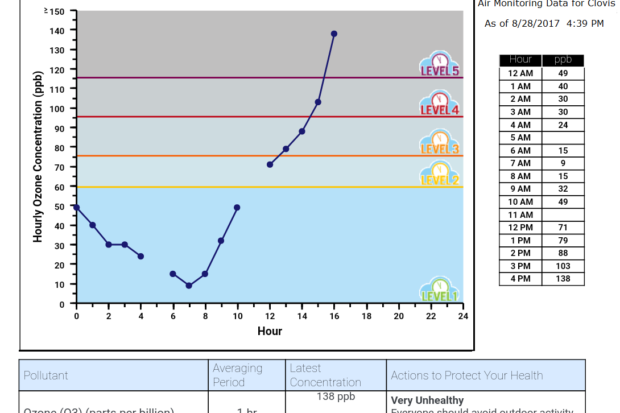
By Tom Frantz
As the dust-reddened sun rose over the city, residents reluctantly crawled out of bed shaking off headaches from oxygen deprivation due to a night of breathing dirty air. Talking heads informed listeners of possible record heat in the afternoon. A chart predicted an air quality index of orange meaning the air would be unhealthy for anyone who needed to breathe a lot that day.
At 7 a.m., the temperature was 76 degrees and the humidity was 65%. It was partly cloudy, with a chance of meatballs (meaning this was the kind of day when older dairy cows show a decrease in milk production and are sent to the slaughterhouse before they collapse and are only good for dog food).
Parents made sure their asthmatic schoolkids had their $50 inhalers containing doses of albuterol. Farmworkers were in the fields before daybreak cutting bunches of grapes, poling almonds off trees and picking up watermelons with a faint but acrid smell of pesticides in their noses. High school football players and cross-country runners were working out early in the still, heavy air and feeling sick to their stomachs. Retired folks were trying to catch another hour of sleep because it had been a long night of uncomfortable breathing.
Ozone levels had been bad for five days in a row. It had been bad for 10 weeks in a row except for a slight reprieve in mid-August.
To make a long story short, Fresno records for both heat and ozone levels were set on the afternoon of Aug. 28. The 109 degrees around five o’clock tied the record high for the date. The ozone levels between 3 p.m. and 5 p.m. were the worst in nine years. It was also the first time in 20 years that every Fresno monitor, including Clovis, went over the one-hour ozone standard on the same day, making the entire metropolitan area a death zone.
The tragedy that day is people were not warned this was going to happen. People suffered and died because the air was around 30% worse than predicted by the San Joaquin Valley Air Pollution Control District. And, as the ozone reached peak levels, there were no public announcements.
Some people depend on the Real Time Air Advisory Network (RAAN) for hourly pollution updates. Unfortunately, the Central Fresno monitor, where the air was the worst, was offline in the afternoon.
Those who were informed by the RAAN system about the bad air found out too late. This was apparently unexpected, and the RAAN system is not actually real time. It only tells you the level of air pollution about an hour after the fact.
Ozone is a killer of the elderly. A June 28 study by Qian Di of Harvard titled “Air Pollution and Mortality in the Medicare Population” showed that for every 1 PPB increase in ozone there is a 1.1% increase in risk of mortality from all causes for Medicare-aged people. No safe level of exposure was found.
Senior citizens probably suffered the most from not being warned about the high ozone levels on Aug. 28. The death notices in the Fresno Bee for that day only tell part of the story. Ozone damage to lungs can cause death a few days or weeks or even years after the fact.
There is little doubt that a senior citizen in Fresno ran an errand that afternoon and returned home gasping for air and/or coughing. He might have even died later from a heart attack while trying to sleep. His relatives and friends hope the death was quiet and peaceful. They don’t really know about the violent awakening just before death from the drowning feeling of suffocation due to excess exposure to ozone eight hours earlier.
Is our air quality improving? Barely. This summer shows less than a 20% improvement over the peak readings of 20 years ago. There is obviously more work to do.
The bottom line is everyone should be warned to stay indoors as soon as it is known that the pollution average for the hour will be purple or “very unhealthy” on the air quality index. We know the air district can watch these monitor readings minute by minute throughout the day. There is no excuse not to have local media alerts that interrupt regular programming, notifications that buzz cell phones and schools that are advised to keep kids indoors in these situations.
*****
Longtime clean air advocate Tom Frantz is a retired math teacher and Kern County almond farmer. A founding member of the Central Valley Air Quality Coalition (CVAQ), he serves on its steering committee and as president of the Association of Irritated Residents. The CVAQ is a partnership of more than 70 community, medical, public health, environmental and environmental justice organizations representing thousands of residents in the San Joaquin Valley unified in their commitment to improving the health of Californians. For more information, visit www. calcleanair.org.
